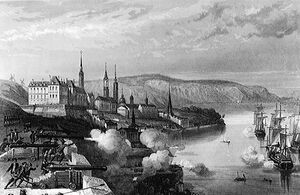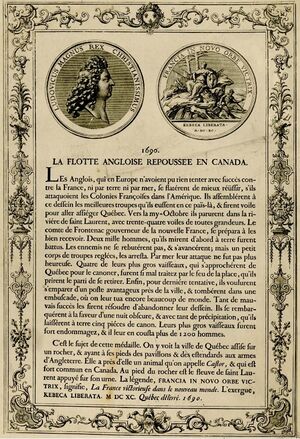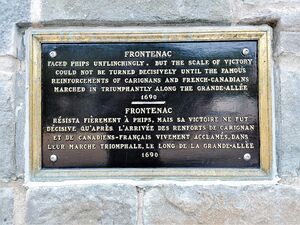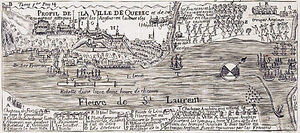- Profile
- Images
Date:
[unknown]
[unknown]
Location: Québec, Canada, New France
Surname/tag: Phips Frontenac
Location: Québec, Canada, New France
Surname/tag: Phips Frontenac
This page has been accessed 217 times.
- Historical event: 16-24 October 1690
- Epoch: King William's War (1688-1697)
- Who was there: Category:Siege of Quebec
- Belligerents:
- Major-General Sir William Phips with 32 ship fleet and 2300 militiamen
- Governor-General Louis de Buade de Frontenac and the people of Quebec
- Outcome: Frontenac prevails. Phips withdraws following a prisoner exchange.
- The Siege of Quebec is also known as the Battle of Quebec and the Defence of Quebec, which names are also claimed by other events in Quebec history.
- Phips
- Major-General William Phips set sail from Boston in command of a military expedition against Québec on 20 August 1690, it was ill-supplied.
- Comte de Frontenac
- Upon receiving word, on 10 October, of recent attacks at Perce and Bonaventure, Governor-General Louis de Buade de Frontenac ordered the immediate preparation of the city for siege.
"[...] I received, on October 10 , at 3 o'clock in the afternoon, a letter from the major of Quebec, in which he informed me that a considerable Abenaki from the Acadian side had come on purpose, by order of his nation, to warn me that there was A very large fleet had left Boston for more than a month, with many troops on it, with the intention of coming to attack and take Quebec." --Frontenac[1]
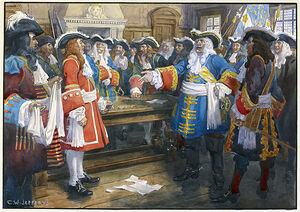
|
| par la bouche de mes canons |
- par la bouche de mes canons
- On 16 October, when envoys delivered terms of surrender from Phips, who was waiting among a fleet of ships, the Governor-General famously declared that his only reply would be by "the mouth of my cannons."
- 'Non, je n'ai point de réponse à faire à votre général que par la bouche de mes canons et de mes mousquets.' —Frontenac[2]
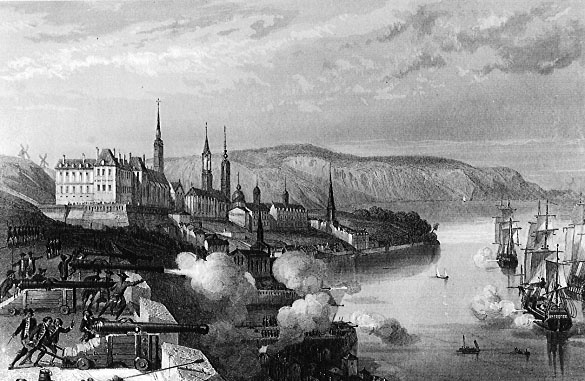
|
| The batteries of Quebec City bombard the English fleet during the Battle of Quebec in 1690. |
- Bonaventure, Maricourt, Longueuil, Sainte-Hélène
- In 1690, Bonaventure on the Saint-François-Xavier returned from Hudson's Bay to Quebec, with Le Moyne de Maricourt onboard. As they approached Quebec, "Le Moyne de Longueuil was able to warn Bonaventure and Maricourt in time, who, in longboats, slipped among the English ships and were able to bring their Canadians to the aid of the capital. With his brothers from Longueuil and Sainte-Hélène, M. de Maricourt took part in the victory of La Canardière which forced the English to decamp and cost Sainte-Hélène his life."[3]
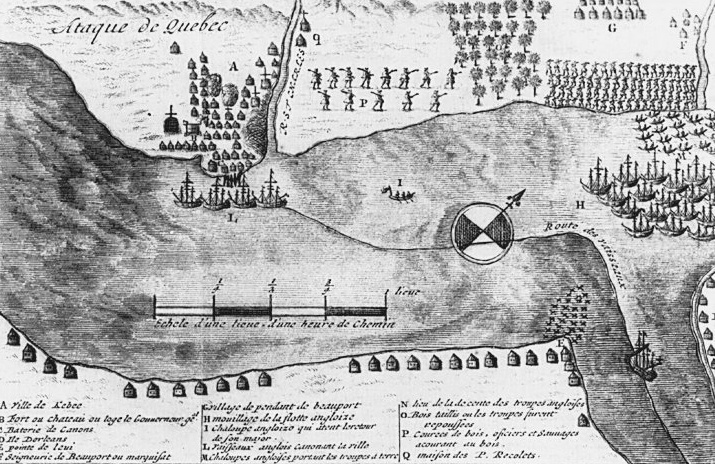
|
| Ataque de Quebec |
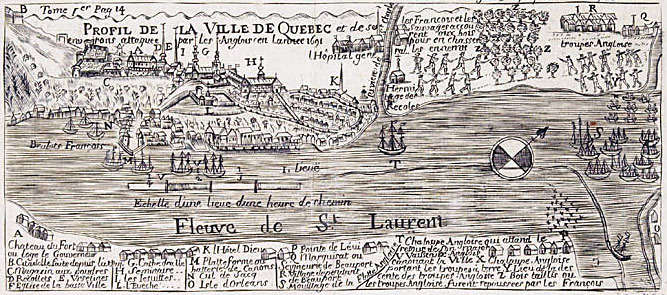
|
| Profil de la Ville de Quebec |
- Prisoner Exchange
- The siege ended on the 24th of October. There was an exchange of prisoners which included on the French side, captives taken during French and Indian raids on New England villages in 1689 and 1690; on the English side included prisoners of Phips's attack on Port Royale. Marie Couillard, mother-in-law of Louis Jolliet, who had been recently captured by Phips on the river, acted as intermediary between Phips and Frontenac in negotiating a prison exchange
- "En 1690, la flotte commandée par Phips s’empara de la barque de Jolliet, confisqua des marchandises évaluées à 10 ou 12 000# et fit prisonnières la femme et la belle-mère du découvreur..."[4]
- Description of a medal made after the French victory having repelled the British attack on Québec in 1690.
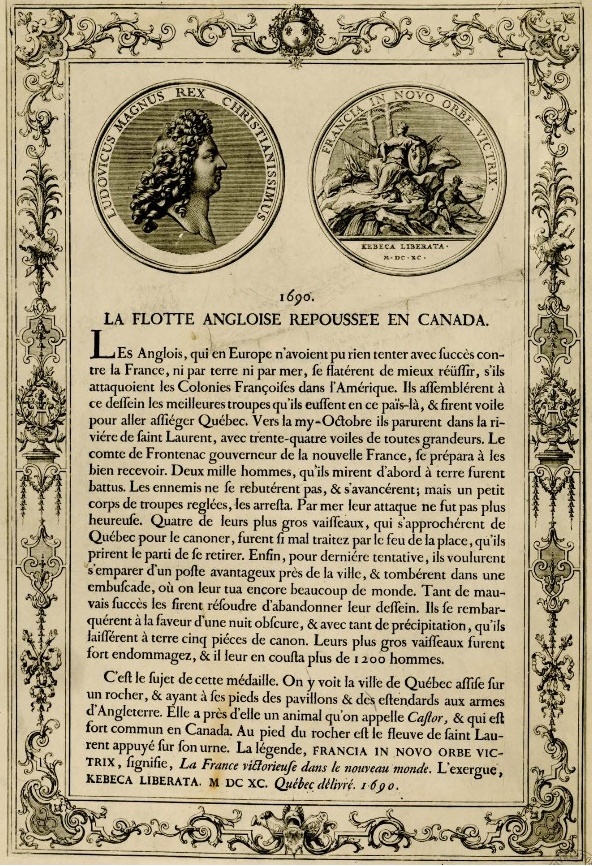
|
| English Fleet Repelled at Canada |
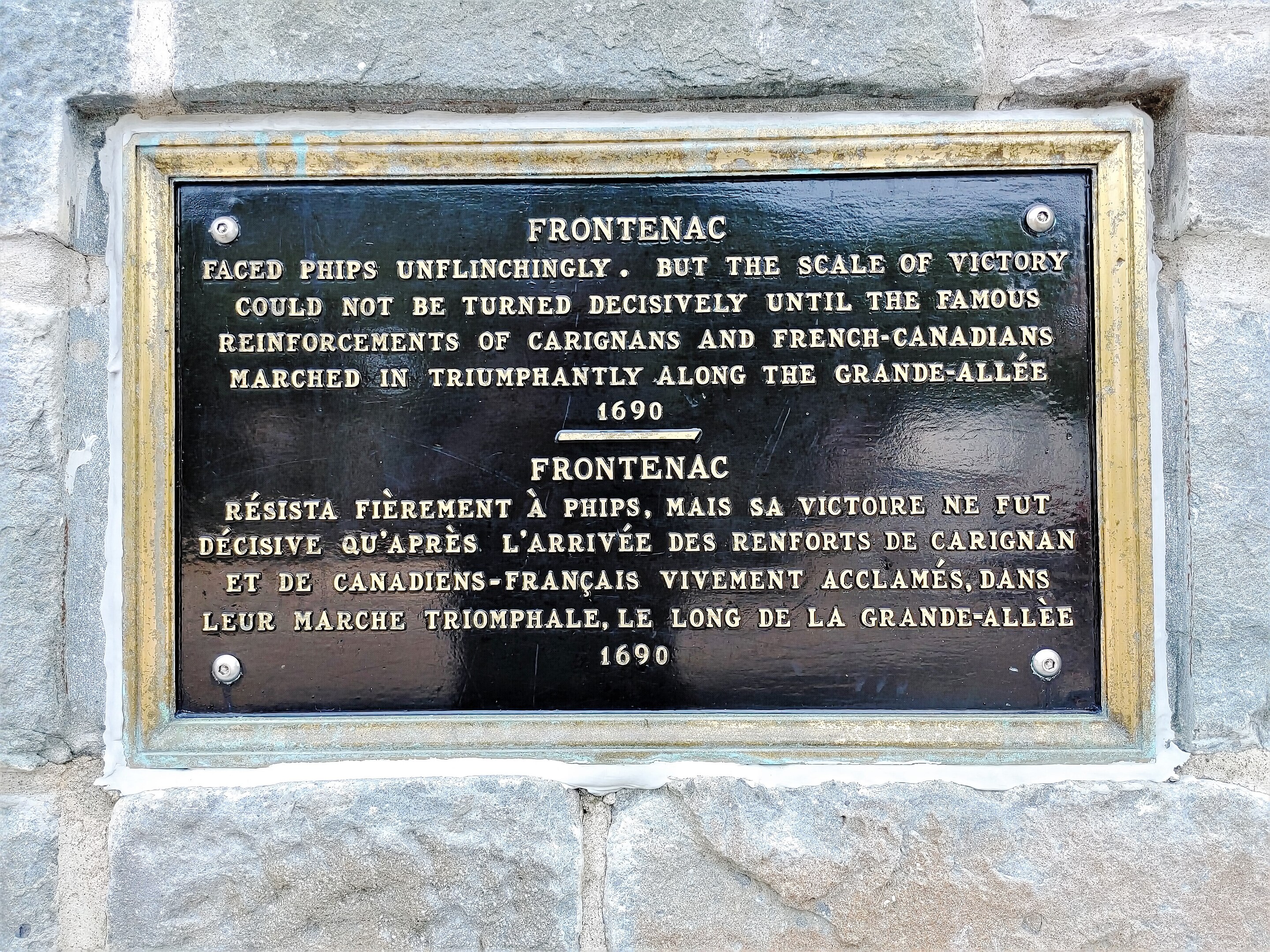
|
| Plaque commemorating the Victory of Frontenac over Phips in 1690 |
Research Notes
- The following excerpts are taken from Ernest Myrand's "Sir William Phips devant Québec - Histoire d'un siège".[2]
"[...] I received, on October 10 , at 3 o'clock in the afternoon, a letter from the major of Quebec, in which he informed me that a considerable Abenaki from the Acadian side had come on purpose, by order of his nation, to warn me that there was A very large fleet had left Boston for more than a month, with many troops on it, with the intention of coming to attack and take Quebec." --Frontenac[5]
"The departure of M. le Comte de Frontenac for Quebec was marked on the 10th of October; as he was ready to embark with M. and Mde l'Intendante, a canoe dispatched by M. Prévost, major of Quebec, arrived at two o'clock in the afternoon, I had made very great diligence and had not left the sept. I brought two of his letters. The first letter was dated the 5th, and he sent him a copy of what the principal savages of Acadia, Abenaki of the nation, deputies expressly by their chiefs, had brought him back. “I am coming shortly to let you know that I learned, through a considerable Englishwoman, that near Pentagouët, 30 ships, of which 3 are very large, are leaving to come and take Quebec; : That these ships are from Boston and four considerable towns; let the English boast of taking Quebec as easily as they took Port-Royal"; This news being learned, the chiefs and the most notable decided that it was necessary to send the great captain of Quebec to warn. I was twelve days ahead as well; it must have been six weeks since these ships left.” --- Relation de Monseignat, p.20.
"Le 8 octobre, le sieur Prévost, major de Québec, eut avis, par un sauvage qui ävait fait une prisonnière anglaise, qu’il était parti de Boston une flotte considérable, avec 2500 hommes pour venir assiéger Québec. Deux jours après, cette nouvelle lui ayant été confirmée par la prise que ces bâtiments firent de deux barques francaises dans le fleuve St-Laurent, il dépécha un canot pour en donner avis à Monsieur le Comte de Frontenac qui était lors à Montréal et envoya une biscaïenne pour reconnaître les ennemis, Ensuite, il donna les ordres nécessaires pour mettre la place en état de faire une vigoureuse défense en rassem- blant dans la ville les habitants des environs et faisant tra- vailler à de bons retranchements dans les avenues et le long des rives..." --- Relation de l'intendant Bochard de Champigny, p.80."
Sources
- ↑ Lettre du Gouverneur [Frontenac] à M. de Seignelay, p.2.
- ↑ 2.0 2.1 Myrand, Ernest,, "Sir William Phips devant Québec - Histoire d'un siège" /, Québec, Imprimerie de L.J. Demers & frère, bureau de l'Événement, 1893, 428 p. [10] f. de pl. : cartes, fac-sim. plan, portr. ; 23 cm, Collections de BAnQ. (Accessed 13 nov 2021) https://collections.banq.qc.ca/ark:/52327/2022077
- ↑ Pierre Daviault. "La Grande aventure de Le Moyne d'Iberville" Ch 06. Texte établi par Albert Lévesque, Éditions Albert Lévesque, 1934 (p. 67-77). (Accessed 30 Nov 2022) Google translation. https://fr.m.wikisource.org/wiki/La_Grande_aventure_de_Le_Moyne_d'Iberville/06
- ↑ Dictionary of Canadian Biography. JOLLIET, LOUIS. (Accessed 30 Nov 2022) http://www.biographi.ca/fr/bio/jolliet_louis_1F.html
- ↑ Lettre du Gouverneur [Frontenac] à M. de Seignelay, p.2.
- Myrand, Ernest. "Sir William Phips devant Québec; histoire d'un siège," Qúebec, Impr. de L.J. Demers & frère, 1893.
- Watkins, Walter Kendall. "Soldiers in the Expedition to Canada in 1690" Preserved by the Hathi Trust. (Accessed 15 Oct 2022) https://catalog.hathitrust.org/Record/100261371
- See also:
- History Media-HD. "Battle of Quebec 1690 – British attack during King William's War" (Accessed 21 Nov 2022) YouTube. https://www.youtube.com/watch?v=dWarNKpgSyQ
- Wikipedia. "Battle of Quebec (1690)." https://en.wikipedia.org/wiki/Battle_of_Quebec_%281690%29
- Space:Raid on Percé (Summer 1690)
- Battle of Rivière Ouelle (October 1690)
Images: 6
Collaboration
- Login to edit this profile and add images.
- Private Messages: Send a private message to the Profile Manager. (Best when privacy is an issue.)
- Public Comments: Login to post. (Best for messages specifically directed to those editing this profile. Limit 20 per day.)
Comments
Leave a message for others who see this profile.
There are no comments yet.
Login to post a comment.

